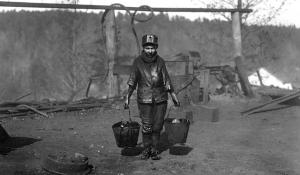
Dahkota Franklin Kicking Bear Brown is a 15-year-old Miwok student who was named a 2013 Champion for Change by the Center for Native American Youth. In 2012, he founded the nonprofit NERDS (Native Education Raising Dedicated Students) to provide peer-to-peer tutoring and mentoring to Native students. His speech for the Center for American Progress on how stereotyped team mascots affect Native youth went viral earlier this year.
Green American/Tracy Fernandez Rysavy: From your personal experience as a student, how are Native stereotyped team mascots harming Native youth?
Dahkota Brown: They really are. Native American youth have the highest dropout rate, the lowest graduation rate, the highest suicide rate among any ethnicity. I honestly believe part of that can be linked to the use of Native mascots. Our teens see things like this fan who goes to all the Philadelphia football games, and when they play the Washington R-word team, he carries a spear with a fake head on it wearing a headdress. We see these people who seem to hate Indians, and it gives this false sense of who we are—they think we’re savage. And these teens lose their cultural identity and don’t feel they fit in anywhere. For me, it’s been a struggle.
I started my own nonprofit, NERDS, or Native Education Raising Dedicated Students. We’re a peer-to-peer tutoring and mentoring program, and a lot of what I hear is that these Native mascots really are offensive to students and do have an effect on their lives.
Green American/Tracy Fernandez Rysavy: Tell me more about NERDS. Why the name “NERDS”?
Dahkota Brown: Back in 2012, when I was in 8th grade, I saw that some of my friends and cousins were on the verge of dropping out, so I encouraged them to come to our Indian peer education and tutoring group after school. We started out small, just a couple of students, and it was a place to hang out and be around good people. I got more and more students coming. Their grades started to improve, and they were feeling better and better about themselves.
One who was in 7th grade at the time hadn’t turned in an English assignment all year, and [after participating in the group], he was the first one to turn in an essay. The teacher was so proud of him and read his essay out loud, and his friends were kind of making fun of him, calling him a nerd. He came to me, and I said, “That’s not so bad. Native people have been called a lot worse.” So we decided to use it as an acronym.
NERDS is now trademarked. We’re a 501(c)3 nonprofit. We started a summer school program last year. We currently have seven chapters in northern California, and we’re trying to reach beyond that. I’ve had contact from Nevada, and I went to South Dakota a couple of months ago to the Rosebud reservation, because they were interested in starting NERDS clubs.
Green American/Tracy Fernandez Rysavy: In addition to removing these mascots, how can schools do better at lifting up Native American youth?
Dahkota Brown: At my school, we have students who have dropped out because our faculty weren’t willing to work with Native students and our culture and lifestyle. [Schools could make a difference by] actually taking the time to sit down with Native students and talk to them about what they’re going through. Try to relate with us on a personal level about our culture.
Our Native students, a lot of the time, are really quiet. We won’t speak up to teachers and don’t really have an advocate who can speak out on our behalf. So we can get pushed to the back of the classroom and ignored.
My brother is going to be a senior at Stanford this year. He’s working on a program for teachers, and he’s testing it out pretty soon in my own district. It provides cultural competence training on how to work with Native students and be sensitive to our beliefs. Schools can e-mail him for more information at dahltonb@stanford.edu.
Brown is also willing to work with any school interested in starting up a NERDS chapter. Contact dahkota.brown@gmail.com. To support NERDS, visit gofundme.com/ansi50/.







